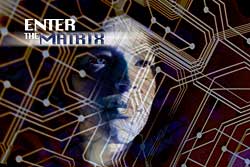Enter the Matrix
Virtual technology has numerous advantages when deciding between a virtual and analog matrix
- By Oliver Vellacott
- Dec 01, 2006
 THE core of most traditional, analog CCTV systems is the video matrix. The matrix is typically an electronics rack situated close to the control room. The matrix is a switch that routes video inputs from cameras to video outputs that are fed to monitors and DVRs/VCRs for recording as required. This is achieved by operators using desk-mounted keyboard controls.
THE core of most traditional, analog CCTV systems is the video matrix. The matrix is typically an electronics rack situated close to the control room. The matrix is a switch that routes video inputs from cameras to video outputs that are fed to monitors and DVRs/VCRs for recording as required. This is achieved by operators using desk-mounted keyboard controls.
The answer to expanding existing, analog matrix systems is to add an IP video system for the additional cameras and equipment. This fully-integrated, hybrid system maintains the original investment in CCTV equipment while providing an expansion path for the future.
A virtual matrix runs on a data network LAN, WAN or metropolitan area network that carries information encoded as TCP/IP. Such networks are now ubiquitous and installed into new buildings as part of the communications infrastructure. The term IP network is now a common phrase to describe this type of network.
In a digital CCTV system, the analog video from cameras is converted to digital data for transmission over the network. The process usually takes place at the camera in the form of an analog CCTV camera connected to a separate encoder unit nearby or by using a self-contained IP camera. Either way, the result is the same -- encoded digital video travels along network cabling.
An analog hardware matrix switches video and PTZ controls, a virtual matrix also will handle the processing of alarm and access control data. It is designed to accommodate the communications required for VoIP and bi-directional, full-duplex audio.
The switching of camera feeds to monitors and recorders is achieved by the video management software. The software, which is normally PC based, manages the control, administration and viewing of live camera feeds and recorded video over the network. The software allows the operator with appropriate permissions to view/analyze live and recorded video from any camera. Operator PC stations running the software can be located anywhere on the network, which allows for the design of truly distributed systems. The network routes the data directly to the appropriate receiver -- there is no central switch like an analog matrix.
Performing Perfectly
The virtual matrix approach can only be justified if the performance of the CCTV system is at least as good as an equivalent analog system. There are many important features to consider when comparing technologies.
Image quality. With modern compression techniques, the argument that the picture quality of digitally-transmitted images is inferior to analog is redundant. Modern MPEG-4 compression technologies are capable of encoding complete images at full, 4 CIF resolution and transmitting video around the network at full frame rates (25 fps for PAL, 30 fps for NTSC).
Digital video is often superior to analog-transmitted images because IP-based transmission is not able to be lost. Image quality obtained at the receiving end of the video, whether it is at a monitoring console or NVR, is identical to the quality transmitted. No degradation occurs during transmission, recording or playback.
Reliability. An analog matrix can be a single point of failure for the incoming video communication lines. Switching, monitoring or recording equipment can bring the entire system to a grinding halt. In a virtual matrix, if part of the network, monitoring or recording equipment goes down, the rest of the system can continue to operate as normal. Redundant power supplies and network ports are now built into equipment as standard, and the technology provides "hot standby" operation. If one network path fails, another can be automatically swapped in. NVRs also can be distributed around the network, providing further levels of redundancy.
Scalability. This is perhaps one of the most important differentiators between the two technologies. To expand a system that uses an analog matrix requires additional coax/fiber cabling that has to be wired to a single location, hardware or even a new matrix if the original unit is full. The expansion is clearly expensive in both cabling and extra hardware, particularly if the new additions are remote from the matrix. Being a scalable solution, matrix users can add the desired cameras, monitors, recorders or control positions to any point on the network with a virtual matrix.
The answer to expanding existing, analog matrix systems is to add an IP video system for the additional cameras and equipment. This fully-integrated hybrid system maintains the original investment in CCTV equipment while providing an expansion path for the future. When the old analog matrix and associated DVRs stop working, the equipment can simply be replaced with a virtual matrix and NVRs.
Video recording. An analog system typically uses DVRs connected directly to the matrix. In a virtual matrix system, NVRs are used. It is important to differentiate between DVRs and NVRs, since both technologies are referred to as digital. A DVR digitally compresses analog video feeds and stores the information on a hard drive. The term digital refers to compression and storage technology, the transmitted video images. The DVR has to be located near the analog matrix. In contrast, an NVR stores digital images directly from the IP network.
The advantage of NVR-based architecture is the equipment can be located anywhere on a network, at the monitoring center, adjacent to camera clusters, on the edge of a network or collected together in a hardened environment. In use, location is transparent to an operator; the recorded video stream from any camera can be viewed by any operator at any point on the network. NVRs record and replay simultaneously -- recordings on any one machine can be remotely viewed by a number of authorized operators spread across the network simultaneously, all totally independently.
Cost. In many cases, the bandwidth needed to transmit CCTV across an existing network can be easily accommodated on the existing corporate network, giving a virtual matrix a distinct cost advantage compared to analog systems by removing the need for additional cabling. The infrastructure is not only carrying and switching video images, but alarms, control signals, access control data and audio. IP network switches are typically 10 percent of the cost of an analog matrix with an equivalent number of ports.
Latency. It doesn't matter if the operator witnesses an event one or two tenths of a second after it really happened. The time when latency matters is when an operator is following a target using PTZ controls. If there is any significant delay in the camera image being updated, as the camera is being moved to track the target, it becomes difficult for the object to be followed successfully. In virtual matrix systems, latency occurs when bandwidth of the transmission channel is insufficient for the volume. Nontheless, if a system is well-designed latency will not occur. In the event where latency does occur, there are possible remedies -- increase the available bandwidth or reduce the data volume, or both. A number of techniques to manage bandwidth can be employed.
Network bandwidth. This is one of the most common arguments employed to use against the virtual matrix. But it has no real substance. In some circumstances, the bandwidth may need increasing, but that is still preferable to laying down a totally new, but already technologically outdated, analog-cabling infrastructure.
|
Safeguarding the Meissen Heritage
Quality porcelain, craftsmanship kept under watchful eye of cameras
By Katharina Geutebrück
 The name Meissen is synonymous with high-quality porcelain and exquisite craftsmanship. The first in Europe, this hard-paste porcelain was developed in the early 18th century under royal patronage in the German state of Saxony. The factory in Meissen soon became famous for exclusivity, style and perfect form. Nearly 300 years later, the business draws visitors from all over the world, and the Staatliche Porzellan-Manufaktur Meissen GmbH has had to expand both its visitor facilities and its CCTV system to provide adequate space and protection for its displays, demonstration workshops, exhibitions and retail operation. The name Meissen is synonymous with high-quality porcelain and exquisite craftsmanship. The first in Europe, this hard-paste porcelain was developed in the early 18th century under royal patronage in the German state of Saxony. The factory in Meissen soon became famous for exclusivity, style and perfect form. Nearly 300 years later, the business draws visitors from all over the world, and the Staatliche Porzellan-Manufaktur Meissen GmbH has had to expand both its visitor facilities and its CCTV system to provide adequate space and protection for its displays, demonstration workshops, exhibitions and retail operation.
The Museum
The early 20th-century museum, which houses the company’s 20,000 piece historic porcelain collection and displays 3,000 items in sumptuous surroundings, was enlarged in 2005 with the addition of a modern extension. The new structure is intended to resemble a book, standing on end with its pages slightly opened. The pages are represented by vertical concrete ribs interspersed with glass panes and hand-crafted porcelain panels, depicting the history of Meissen porcelain.
The System
Video cameras monitor the buildings inside and out, and integral motion detection functions alert staff if anyone strays beyond safe limits. The GEUTEBRÜCK CCTV system supports high levels of automation and is customized to suit staff routines. Complex procedures run from a single keystroke to ease workloads and enable fast reactions. The CCTV, fire and intruder alarm systems are all integrated into a higher-level alarm management system, and open interfaces also enable the video and intercom systems to work together, so that control room staff can see and converse with delivery drivers and other official visitors.
Katharina Geutebrück studied electronic engineering and worked in Italy and France before returning to the family firm in Germany, where she has been managing director since 1999. |
Opening New Opportunities
There has been an increasing number of high-profile installations of IP video systems around the world, such as the two most recent Olympic Games in Athens and Turin, where more than 2,500 cameras were successfully integrated using IP video technology. The flexibility and scalability offered by IP video systems means the technology can be used for applications that are just not possible or cost effective with analog CCTV solutions, opening up new opportunities for both end users and systems integrators.
This article originally appeared in the December 2006 issue of Security Products, pgs. 32-34.